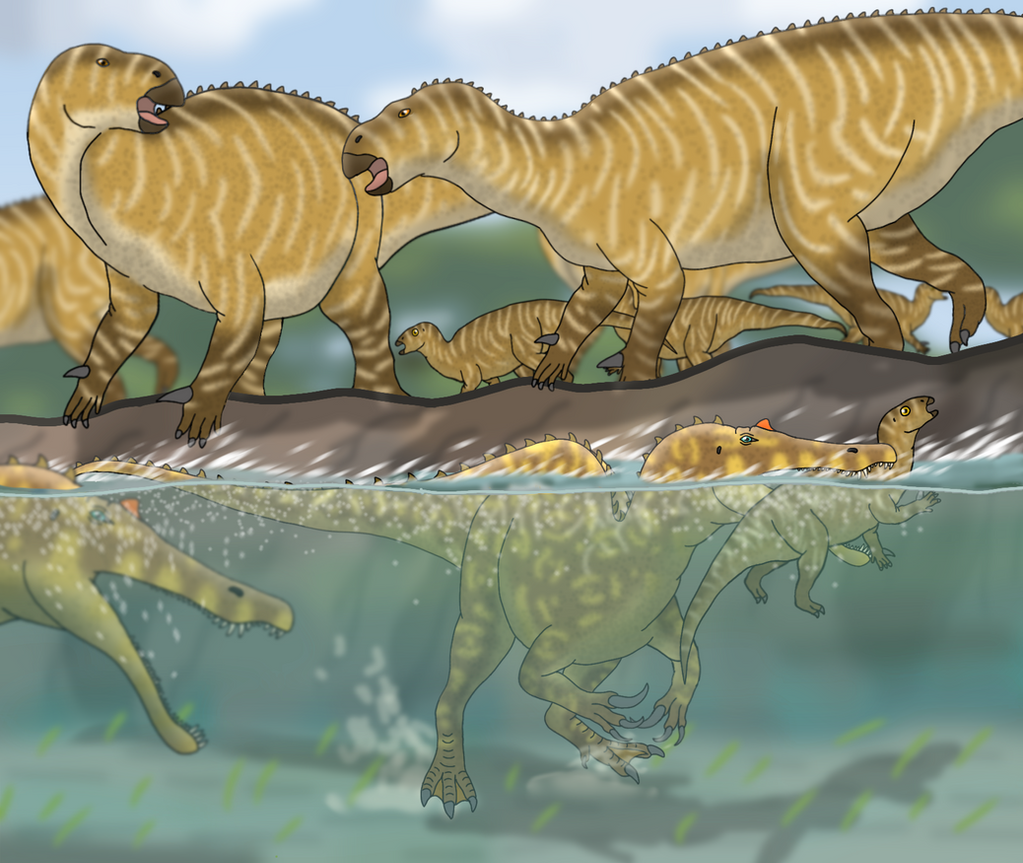HOME | DD
 Olmagon — Crossing With the River Beasts
Olmagon — Crossing With the River Beasts

#megalosauroidea #aquatic #baryonyx #cretaceous #digitalart #digitaldrawing #digitalillustration #digitalpainting #dinosaur #flood #herd #iguanodon #juvenile #mesozoic #ornithopod #paleoart #paleontology #river #spinosaur #swimming #theropod #underwater #ornithischian #iguanodontidae #paleoillustration #spinosauridae #baryonyxwalkeri #dinosaurday #baryonychinae #iguanodonbernissartensis
Published: 2022-05-17 01:11:32 +0000 UTC; Views: 29014; Favourites: 354; Downloads: 4
Redirect to original
Description
125 million years ago during the early Cretaceous period of what is now the Weald Clay Formation in England, a herd of large herbivorous dinosaurs named Iguanodon bernissartensis travel with their young during the wet season, but find that recent heavy floods have led to a ditch in the area to become essentially a temporary river. As the water flows through the area, aquatic animals also move in, as the Iguanodon herd soon finds out when one of their young get too close to the water and gets snatched in the jaws of a semiaquatic predator. Several large semiaquatic predatory dinosaurs of the species Baryonyx walkeri have already arrived into these waters and while they feed mainly on fish, one takes the opportunity to add a young Iguanodon to its diet, pulling it underwater as its family can only helplessly watch from the land.Drawing intended for Dinosaur Day (May 15) but ended up kinda late, and as my birthday is also around this time I went on to draw one of my favorite dinosaurs, Baryonyx, alongside one of the most important paleontological discoveries ever, Iguanodon. I have wanted to draw these two interacting for so long. Also I noticed I have committed the crime of not drawing any megalosauroids (including spinosaurs) in over a year despite drawing paleoart regularly so I better fix it.
First discovered in England in 1983, Baryonyx is a carnivorous theropod dinosaur that lived during the early Cretaceous period and grew 7.5 to 10 meters long. This animal belonged in the Spinosauridae family, and like other spinosaurs it had a long slender snout and large hand claws, adaptations for catching and eating fish. The stomach region of the holotype Baryonyx specimen actually has fish scales inside, confirming it was a fish-hunter, but also has the bones of a young Iguanodon, showing they also ate terrestrial prey on occasion (or at least scavenged it). While some spinosaurs (namely those of the Spinosaurinae subfamily like Spinosaurus) had short legs and large sails on their backs, those of the Baryonychinae subfamily (which includes Baryonyx) lacked sails and still had long, developed legs. In the past it has been suggested to hunt fish from the shore like a heron, but a bone density study that came out earlier this year finds that despite those long walking legs,Baryonyx was well-capable of swimming and diving underwater to catch fish. Spinosaur remains from across England and even continental Europe were once assigned to the Baryonyx genus, however almost all of these have since been reassigned to their own seperate genera such as Iberospinus, Ceratosuchops and Riparovenator, and today Baryonyx itself is only confidently known from the Weald Clay Formation of England.
Growing on average 9 meters long, with some exceptional specimens possibly reaching 13 meters, Iguanodon was a large herbivorous ornithopod dinosaur, and important in paleontology in that it is the first non-avian dinosaur to be discovered. First named in 1825, it was initially thought to be something akin to a gigantic iguana with a horn on its nose, but today it's known better what this dinosaur looked like and that the supposed nose horn was actually a thumb spike (possibly used for defence or collecting food). Some sites like Bernissart, Belgium have preserved huge bone beds of many Iguanodon that died together (at least 38 in Bernissart), including some juveniles, suggesting this dinosaur lived in large herds along with their young. Over the centuries since Iguanodon was first described, ornithopod dinosaur remains from across the world have been found and assigned as additional Iguanodon species, making it appear the genus lived almost worldwide from the middle Jurassic to the middle Cretaceous. However, today the vast majority of these have been placed in their own seperate genera, and Iguanodon itself is currently believed to have only lived across Europe and within the early Cretaceous only.
Related content
Comments: 27

👍: 0 ⏩: 1

👍: 0 ⏩: 1

👍: 1 ⏩: 1

👍: 1 ⏩: 1

👍: 1 ⏩: 1

👍: 1 ⏩: 0

👍: 0 ⏩: 0

👍: 1 ⏩: 1

👍: 0 ⏩: 2

👍: 0 ⏩: 0

👍: 2 ⏩: 2

👍: 0 ⏩: 0

👍: 0 ⏩: 0

👍: 1 ⏩: 2

👍: 1 ⏩: 0

👍: 0 ⏩: 1

👍: 1 ⏩: 1

👍: 0 ⏩: 2

👍: 1 ⏩: 1

👍: 0 ⏩: 0

👍: 1 ⏩: 0

👍: 0 ⏩: 0























